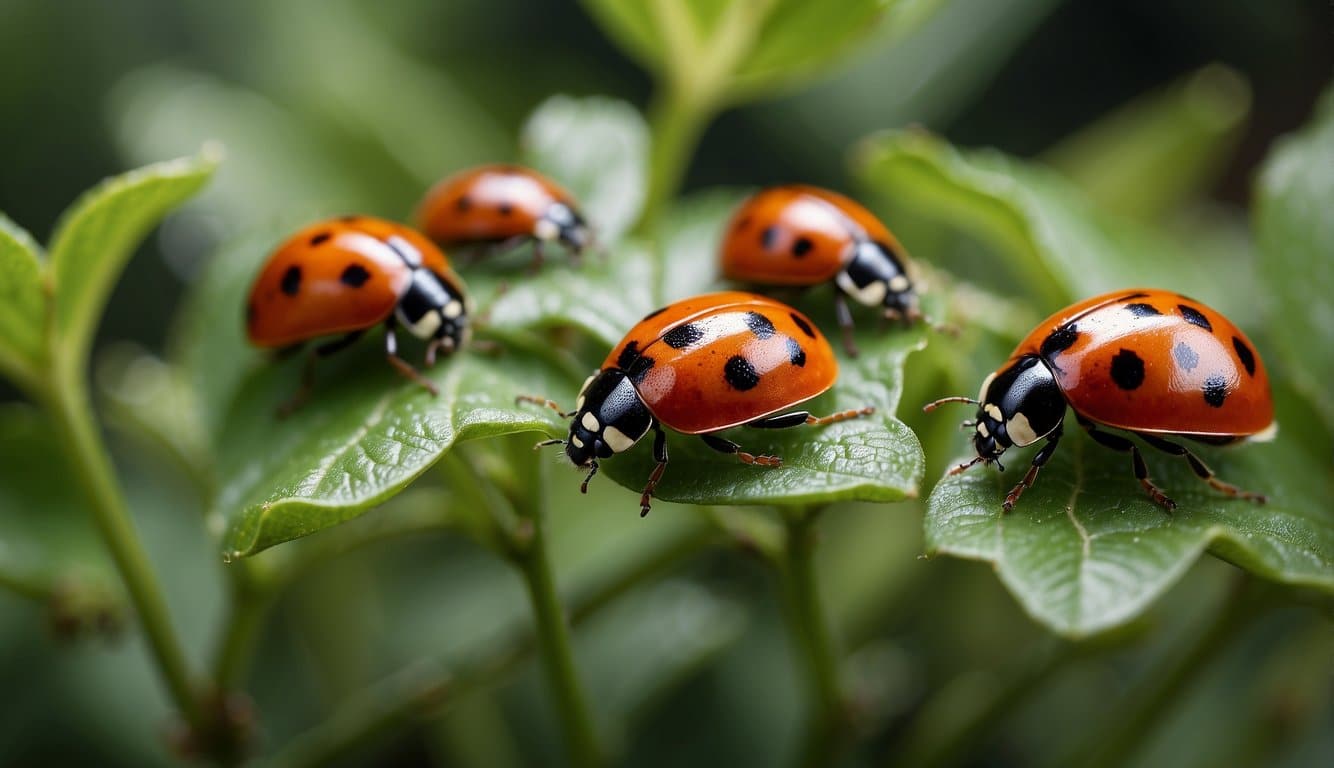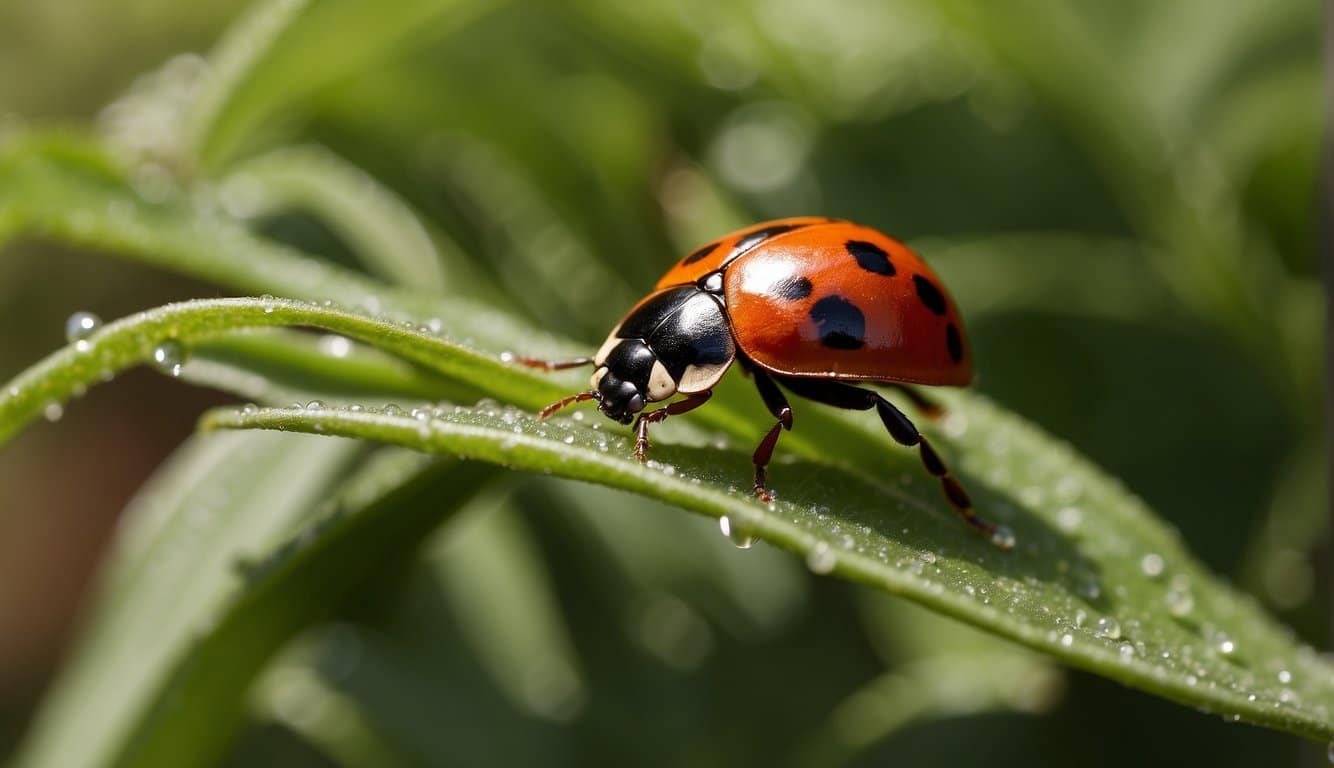Identifying Ladybug Infestations
When your space seems to buzz with more red and black polka-dotted visitors than usual, you might be facing a ladybug infestation.
Here’s how to spot the signs:
- Clusters of Ladybugs: Often, they’ll congregate around windows or light sources, since they’re drawn to bright areas.
- Entry Points: Look for gaps around windows, doors, or in siding where these tiny critters could sneak in. Sealing these can prevent a full-blown invasion.
Visual Inspection:
Ladybugs don’t just stop for a chat; they come in droves.
Keep an eye out for:
- Ladybug Larvae: These guys look nothing like their parents. They’re more alligator-like, so don’t mistake them for another pest!
- Excessively Sunny Areas: Your sunniest spots are ladybug magnets. Notice more activity there? It’s a flag.
What They Leave Behind:
- Yellow Stains: When ladybugs get stressed (as they often do indoors), they ooze yellow fluid, leaving behind marks.
- Allergens: Some folks might react to their presence with allergy-like symptoms. If you’re sneezing more than usual, those little red shells could be the cause.
Natural Repellents
When your home becomes a hotspot for ladybugs, turn to nature for your defense strategy.
Let’s explore how effective natural repellents can safeguard your space without the need for harsh chemicals.
Using Citrus and Clove Scents
- Citrus: Ladybugs are not fans of citrus scents. Lemon or orange essential oils can do the trick. Simply mix a few drops with water, and spritz around your home where ladybugs frequent.
- Cloves: Whole cloves or clove oil emit a fragrance that ladybugs dislike. Place cloves in problem areas or use clove oil in a diffuser to send those spotted intruders packing.
Deploying Diatomaceous Earth
- Diatomaceous earth is a fine powder made from the fossilized remains of tiny aquatic organisms known as diatoms.
- Apply it along window sills or doorways:
- Obtain food-grade diatomaceous earth.
- Sprinkle a thin layer in areas where ladybugs enter or congregate.
- Reapply after cleaning or rain.
Encouraging Natural Predators
Birds, such as swallows and martins, are natural predators of ladybugs.
Enhance your garden’s allure for these feathered friends by:
- Installing birdhouses to provide shelter.
- Planting native species that produce berries and seeds, attracting a variety of birds.
- Avoiding the use of pesticides so that birds can safely forage for ladybugs.
Mechanical Removal Methods
When ladybugs invade your space, turning to mechanical means can swiftly address the issue without the use of chemicals.
Two straightforward techniques—light traps and vacuums—can effectively diminish your ladybug guests.
Setting Up Light Traps
Light traps are a nifty way to captivate and contain ladybugs using their attraction to bright areas.
Here’s how to maximize their effectiveness:
- Choose a Location: Set up light traps near points of entry or in dark spaces that are known hotspots for ladybugs.
- Maintenance: Regularly check the traps, disposing of any captured ladybugs and refreshing the light sources as necessary.
Vacuuming Them Up
The simplicity of vacuuming offers a quick and non-toxic method to clear your home of ladybugs.
- Soft Brush Attachment: Use this on your vacuum to gently collect ladybugs without harming them.
- Immediate Release: After vacuuming, promptly release the ladybugs outside, away from your home to prevent re-entry.
- Tip: To avoid the ladybugs releasing their yellow, staining fluid, consider using a stocking insert within the vacuum hose.
Preventive Strategies
Before you even think about battling ladybugs inside your home, focusing on prevention can save you a ton of hassle.
Here’s how to fortify your fortress against these speckled invaders.
Sealing Entry Points
- Inspect Your Home: Grab a magnifying glass—just kidding, but do give your home’s exterior a Sherlock-Holmes-worthy examination. Check for cracks or openings around windows, doors, and foundations.
- Seal the Deal: Once you’ve spotted potential bug doors, it’s time to seal them up. Use caulk to cover any small gaps and weather stripping for larger spaces. Think of it as putting up a “No Vacancy” sign for ladybugs.
Maintaining a Clean Environment
- Regular Cleaning: Keep your home spick and span. Ladybugs love clutter, especially if it’s outside close to your house.
- Landscaping: Trim vegetation away from your home’s exterior; it’s like telling ladybugs there’s no free lunch, and that stops them from seeing your home as an insect hotel.
Chemical Solutions
When dealing with a ladybug infestation, chemical solutions can be an effective route, particularly if you’re looking for quick results. The options range from eco-friendly products to professional services, each having its own set of pros and cons.
Eco-Friendly Insecticides
- Diatomaceous Earth: Sprinkle this natural powder around affected areas. Diatomaceous Earth is made from fossilized algae and works by dehydrating the insects that come into contact with it.
- Essential Oil Sprays: Look for sprays that contain neem oil or pyrethrin, which are less harmful to pets and humans but still potent against ladybugs. Apply these sprays around your windowsills and doors.
Professional Extermination Options
- Licensed Pest Control Services: If you’re facing a large infestation, hiring professionals might be your best bet. These experts use regulated pesticides that are often more powerful than over-the-counter options.
- Scheduled Maintenance Programs: Consider signing up for a regular pest control service. This ensures long-term relief with periodic treatments tailored to your home’s specific needs.
Frequently Asked Questions
When it comes to managing a ladybug invasion, knowing your options for repelling and removing these insects is key. Explore natural remedies, effective elimination techniques, and non-lethal measures to maintain a ladybug-free home.
What natural remedies can help repel ladybugs from my home?
- Use a blend of lemon or citrus oil mixed with water and spray it around windows and doors where ladybugs may enter.
- Place cloves or bay leaves in areas of your home to deter ladybugs, as they dislike the scent.
What are the most effective methods to eliminate ladybugs from inside my house?
- A vacuum cleaner is a swift way to collect ladybugs without harming them so you can release them outside.
- Light traps attract ladybugs using a light source and then capture them for release or disposal.
What household substances can quickly exterminate ladybugs?
- Soapy water sprayed directly on ladybugs can effectively kill them by breaking down their protective outer layer.
- Diatomaceous earth sprinkled in areas where ladybugs gather may also act as a deterrent and an exterminator.
Is it necessary to kill ladybugs that enter my living space, or should they be left alone?
- Ladybugs are generally beneficial insects outdoors, so consider removing them without lethal means.
- If ladybugs become a nuisance, focus on non-toxic methods to mitigate the inconvenience they may cause.
How can I deter ladybugs from congregating around the exterior of my house?
- Keep your outdoor lights off when not needed, as lights can attract ladybugs to your home.
- Maintain a tidy garden and seal cracks or openings in your home’s exterior to discourage ladybug gatherings.
What are the non-lethal ways to remove ladybugs from my home?
- Use a jar or container to gently capture ladybugs and relocate them outdoors.
- Install door sweeps and weather stripping to prevent ladybugs from entering your home in the first place.
Last update on 2025-04-02 / Affiliate links / Images from Amazon Product Advertising API




